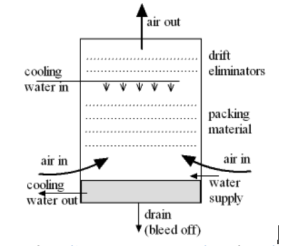No Nonsense Water Treatment – Cooling Tower Efficiency and Approach
Cooling towers use the evaporation to cool the circulated water. They can achieve water temperatures below the dry bulb temperature – tdb – of the air cooling air but not the wet bulb temperature.
Example Dry Bulb = 94F
Relative Humidity = 23%
Dew Point = 49F
Dew Point Depression = Temp – Dew point = 94-49 = 45
Divide by 3 = 45/3 = 15
Subtract from temperature to find approximate wet bulb = 95-15 = 80F
The coldest water the tower could produce is 80F
The temperature difference between inlet and outlet water (ti – to) is normally in the range 10 – 15 oF.

Cooling towers are rated in terms of cooling tower approach and cooling tower range, where the approach is the difference in temperature between the cooled-water temperature and the air wet bulb – twb – temperature
Example from below data
Approach 85 – 80 = 5 F
the range is the temperature drop across the tower
Example from below data
Range = 95 – 85
The cooling tower efficiency can be expressed as
μ = (ti – to) 100 / (ti – twb) (1) where Example
μ = cooling tower efficiency – common range between 70 – 75%
ti = inlet temperature of water to the tower 95
to = outlet temperature of water from the tower 85
twb = wet bulb temperature of air (oC, oF) 80
Example Tower Efficiency= (95-85) / (95-80) = 66% Tower Efficiency
The water consumption of a cooling tower is Evaporation + Bleed + Drift ( drift will be minor in most cases )
1.5 GPH / Ton of evaporation
If Cycles = 3 then bleed = 1.5/(3-1) +0.75 GPH / Tn
2.25 GPH / Tn
